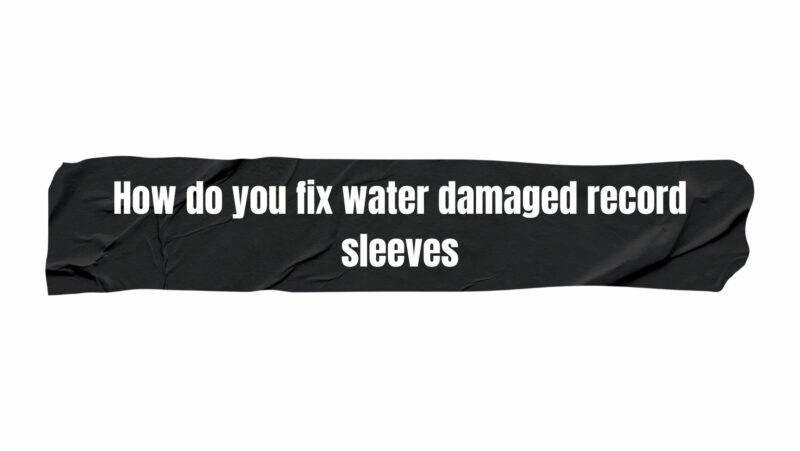Vinyl records encapsulate more than just music; they embody the passion, artistry, and emotions of the artists who created them. However, mishaps like water damage can threaten the integrity of record sleeves, potentially damaging the precious album artwork and historical significance they carry. Repairing water-damaged record sleeves requires a delicate touch, meticulous techniques, and a deep understanding of restoration principles. In this article, we will explore the causes and effects of water damage on record sleeves, underline the importance of proper restoration, and provide an in-depth guide on how to effectively repair water-damaged sleeves while preserving their artistic value.
Understanding Water Damage on Record Sleeves
Water damage can wreak havoc on record sleeves, leading to staining, warping, and deterioration. The primary causes of water damage include:
- Accidental Spills: Mishaps such as liquid spills, splashes, or leaks can quickly saturate record sleeves, causing immediate damage.
- Floods or Moisture Exposure: Prolonged exposure to high humidity, floods, or damp environments can lead to water absorption by the sleeves, resulting in warping and mold growth.
- Improper Storage: Incorrect storage in areas prone to moisture, such as basements or attics, can expose record sleeves to the risk of water damage over time.
- Condensation: Rapid temperature changes can cause condensation to form on record sleeves, leading to moisture seeping into the material.
The Significance of Proper Restoration
Repairing water-damaged record sleeves isn’t just about restoring their visual appeal; it’s about preserving the historical, cultural, and emotional value of the music they hold. Record sleeves often feature iconic artwork, information, and visual elements that contribute to the album’s identity. Proper restoration ensures that these details are conserved, enabling collectors, enthusiasts, and music lovers to connect with the past and future through these artifacts.
Step-by-Step Guide to Repairing Water-Damaged Record Sleeves
Restoring water-damaged record sleeves requires careful consideration and the right techniques to prevent further damage. Here is a comprehensive guide to effectively repair water-damaged sleeves:
- Assessment and Evaluation: Begin by evaluating the extent of water damage. Take note of staining, warping, mold growth, and any other visible issues.
- Isolation and Drying: If the sleeves are damp, gently remove the vinyl records from inside and let them air-dry separately. Lay the damp sleeves flat on a clean, dry surface away from direct sunlight or heat sources. Elevate them slightly using objects like clean towels to allow air circulation.
- Absorbent Materials: For damp sleeves, place clean, white, unprinted paper towels between each layer to absorb excess moisture. Change the paper towels periodically until the sleeves are completely dry.
- Mold Prevention: If mold is present, take caution to prevent its spread. Isolate the affected sleeves and consult professional restoration services if mold growth is extensive.
- Warp Correction: To address warping, place the sleeves between two clean, flat, heavy objects, like books or boards. Leave them in this position for several days to help flatten the sleeves.
- Stain Removal: Gently blot any stains with a clean, damp cloth. Avoid rubbing, as it can spread the stain. Test any cleaning solution on an inconspicuous area before applying it to the stain. Use a mild soap solution or a specialized vinyl record cleaning solution on a soft cloth to clean stains. Always blot, don’t scrub.
- Spot Testing: If you plan to use any cleaning solutions, adhesive, or restoration products, spot test them on a small, inconspicuous area to ensure they don’t damage the sleeve’s material or ink.
- Professional Restoration: For significant water damage, mold growth, or valuable sleeves, consult professional restoration services. Experts have the expertise and equipment required to effectively restore water-damaged sleeves.
Conclusion
Repairing water-damaged record sleeves is a meticulous process that requires attention to detail and patience. Preserving the album artwork, cultural significance, and emotional value embedded in these sleeves is essential for collectors and music enthusiasts. By understanding the causes of water damage and employing appropriate restoration techniques, you can successfully repair water-damaged sleeves while ensuring their durability and maintaining their artistic essence. Remember, each repair effort contributes to the preservation of musical history and the connection between generations of music lovers, ensuring that the melodies and memories endure for years to come.

